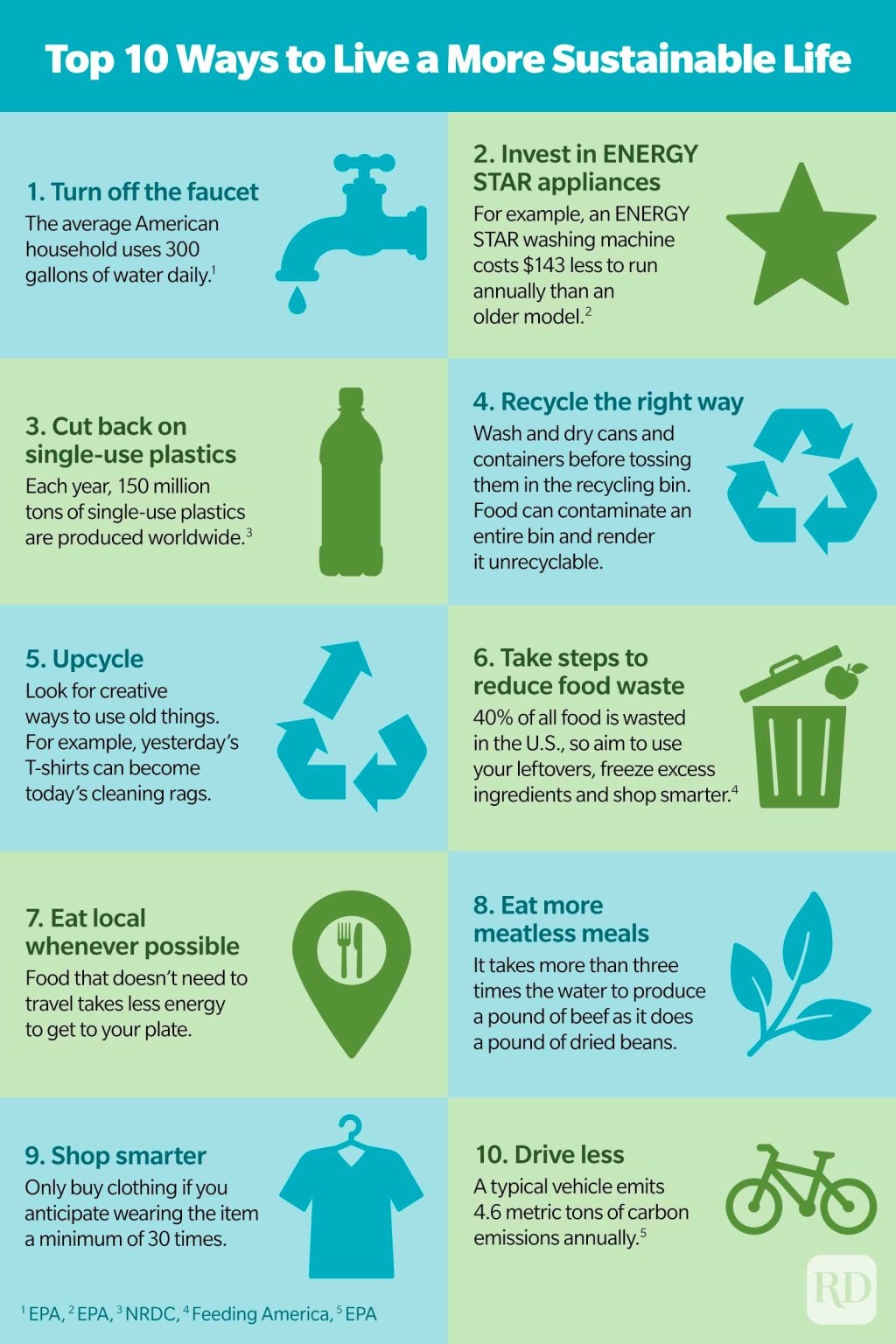Unlocking Possibilities: Embrace Sustainable Living For A Greener Future
Sustainable Living for a Better Future
Introduction
Dear Readers,
2 Picture Gallery: Unlocking Possibilities: Embrace Sustainable Living For A Greener Future


Welcome to this informative article on sustainable living. In today’s world, where environmental concerns are becoming increasingly significant, adopting sustainable practices has become more important than ever. By making conscious choices in our daily lives, we can contribute towards a better future for ourselves and the planet. In this article, we will explore the concept of sustainable living, its benefits, and how we can incorporate it into our lifestyles.

Image Source: www.rd.com
Let’s dive in and discover the key aspects of sustainable living!
What is Sustainable Living?
🌱 Sustainable living refers to a lifestyle that aims to reduce individual or societal impact on the environment and preserve natural resources for future generations. It involves making conscious choices in various aspects of our lives, such as energy consumption, waste management, transportation, and food consumption.
🌍 By adopting sustainable practices, we can help combat climate change, reduce pollution, conserve resources, and protect biodiversity. Sustainable living is not about depriving ourselves but rather finding a balance between our needs and the needs of the planet.

Image Source: googleusercontent.com
🏡 Let’s explore some key principles and actions that promote sustainable living:
1. Energy Conservation
🔌 Energy conservation plays a vital role in sustainable living. By reducing our energy consumption and using renewable energy sources such as solar or wind power, we can minimize our carbon footprint. Simple actions like turning off lights when not in use, using energy-efficient appliances, and insulating our homes can make a significant difference.
🌞 Additionally, supporting and advocating for renewable energy initiatives can contribute to the transition towards a more sustainable energy system.
2. Waste Reduction and Recycling
🗑️ Waste management is another crucial aspect of sustainable living. By reducing our waste generation, reusing items, and recycling materials, we can minimize the amount of waste sent to landfills and conserve natural resources.
♻️ Implementing practices such as composting food scraps, using reusable containers, and avoiding single-use plastics can significantly reduce our environmental impact. Moreover, supporting and promoting local recycling programs and initiatives can contribute to creating a circular economy.
3. Sustainable Transportation
🚲 Transportation is responsible for a significant portion of greenhouse gas emissions. By choosing sustainable transportation options, such as walking, cycling, carpooling, or using public transport, we can reduce our carbon footprint and improve air quality.
🚆 Additionally, advocating for the development of efficient public transportation systems and supporting initiatives that promote electric vehicles can contribute to sustainable mobility.
4. Conscious Consumption
🛍️ Sustainable living involves being mindful of our consumption patterns. By opting for eco-friendly and ethically produced products, we can support businesses that prioritize sustainability and responsible practices.
🌿 Choosing organic and locally sourced food, reducing water consumption, and avoiding excessive packaging are some ways we can make a positive impact on the environment. By making informed choices, we can encourage sustainable production and contribute to a greener future.
5. Sustainable Food Choices
🥦 Our food choices have a significant environmental impact. By opting for plant-based or vegetarian diets, we can reduce greenhouse gas emissions, conserve water, and minimize deforestation associated with animal agriculture.
🌱 Additionally, supporting local and organic food producers, reducing food waste, and practicing sustainable farming methods contribute to a more sustainable food system.
6. Water Conservation
💧 Water is a precious resource, and conserving it is crucial for sustainable living. By being mindful of our water usage, fixing leaks, collecting rainwater, and using efficient irrigation systems, we can help preserve this vital resource.
🌍 Supporting initiatives that promote water conservation and advocating for responsible water management practices can contribute to a more sustainable future.
Advantages and Disadvantages of Sustainable Living
👍 Advantages:
1. Reduced environmental impact: By adopting sustainable practices, we can help mitigate climate change, reduce pollution, and protect ecosystems.
2. Cost savings: Sustainable living can lead to financial savings through reduced energy consumption, waste reduction, and conscious consumption.
3. Health benefits: Sustainable living often involves choosing healthier food options, promoting physical activity, and minimizing exposure to harmful substances.
👎 Disadvantages:
1. Initial costs: Some sustainable practices may require upfront investments, such as installing solar panels or purchasing energy-efficient appliances. However, these costs are often offset by long-term savings.
2. Limited accessibility: Sustainable options, such as organic or locally sourced products, may not be readily available or affordable for everyone. However, supporting and advocating for sustainable alternatives can help make them more accessible.
Frequently Asked Questions (FAQs)
1. Is sustainable living only about environmental concerns?
No, sustainable living encompasses environmental, social, and economic aspects. It aims to create a balance between these three pillars for a better future.
2. Can one person’s actions make a significant impact?
Yes, individual actions collectively contribute to significant changes. Every small step towards sustainable living counts and inspires others to do the same.
3. How can I encourage my community to adopt sustainable practices?
You can organize awareness campaigns, workshops, and community events to educate and involve others. Leading by example and sharing success stories can also inspire change.
4. Are there government initiatives supporting sustainable living?
Yes, many governments are implementing policies and initiatives to promote sustainable practices. These include incentives for renewable energy, waste management programs, and regulations on emissions.
5. Can sustainable living improve the quality of life?
Absolutely! Sustainable living promotes healthier lifestyles, fosters community connections, and ensures a better environment for future generations.
Conclusion
In conclusion, sustainable living is not just a buzzword but a necessary shift towards a better future. By adopting sustainable practices in our daily lives, we can make a positive impact on the environment, conserve resources, and create a more resilient and equitable society.
Let’s embrace sustainable living and be the change we want to see in the world. Together, we can build a sustainable future for ourselves and generations to come.
Final Remarks
Dear Readers,
Thank you for taking the time to read this article on sustainable living. It is our collective responsibility to take action and make sustainable choices in our lives. By doing so, we can contribute towards a more sustainable and resilient future for ourselves and the planet.
Remember, every small step counts, and it’s never too late to start. Let’s make sustainable living a way of life and inspire others to join us on this important journey.
Wishing you a sustainable and fulfilling life ahead!
This post topic: Idensr Lifestyles

